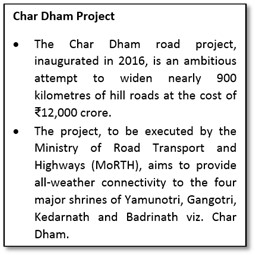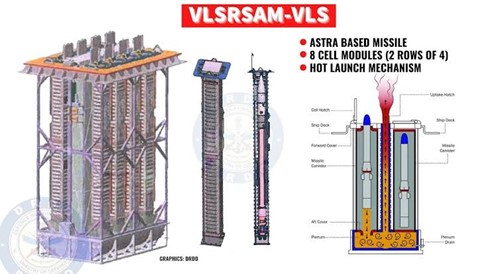Thursday, 16th December 2021
WTO’s ruling on India’s Sugar Subsidy
In News
A World Trade Organisation (WTO) panel has ruled against India’s sugar export subsidy and domestic support to sugarcane growers in a dispute filed by Australia, Brazil and Guatemala.
About the News
- In 2019, Brazil requested consultations with India concerning domestic support as well as all export subsidies, that India allegedly provides for sugar producers and sugarcane farmers. Australia, Guatemala, EU and Thailand joined the consultations subsequently.
- Brazil claimed that the domestic support measures appear to be inconsistent with the Agreement on Agriculture, challenging:
- India's Fair and Remunerative Price (FRP) and State-Advised Prices (SAPs) as well as other payments and policies in favour of sugarcane producers
- three assistance schemes, that operate in conjunction with India's Minimum Indicative Export Quotas (MIEQs) or Maximum Admissible Export Quantity (MAEQ).
- India argued that its mandatory minimum prices are not paid by the Central or State Governments but by sugar mills, and hence do not constitute market price support.
- The WTO Panel ruled in favour of Brazil and noted that:
- for five consecutive sugar seasons, from 2014-15 to 2018-19, India provided non-exempt product-specific domestic support to sugarcane producers in excess of the permitted level of 10% of the total value of sugarcane production. Therefore, the Panel found that India is acting inconsistently with its obligations under the Agreement on Agriculture.
- Regarding export related schemes, the panel found that they are export subsidies within the meaning of Article 9.1(a) of the Agreement on Agriculture. In addition, the panel found that India has provided subsidies contingent upon export performance, which is inconsistent with the SCM Agreement.
- The panel has recommended that India bring its WTO-inconsistent measures into conformity with its obligations under both the Agreements.
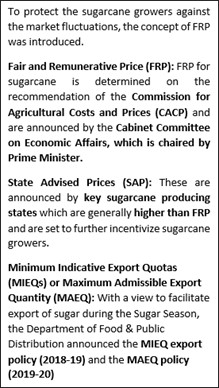
Way Forward for India
- Indian government is planning to submit an appeal to the Appellate Authority. The Appellate Body can uphold, modify or reverse the legal findings and conclusions of a panel, and Appellate Body Reports are adopted by the Dispute Settlement Body (DSB).
- As per WTO rules the current subsidies and domestic market support can be continued till any final decision is taken by the Appellate Authority.
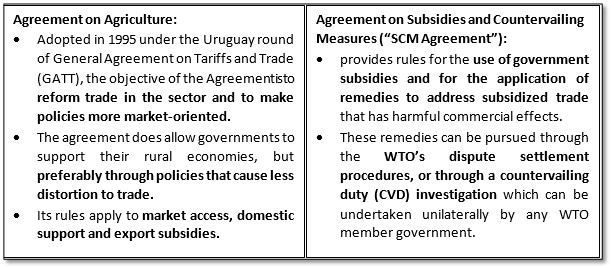
Sources:
HSN codes and GST rates
In News
Decision remains pending on whether the Harmonized System of Nomenclature (HSN) Codes, used for import and export, should be used for GST for domestic transactions needs a relook.
About the News
- Classification of food products and their taxation under the GST has given rise to disputes because the Tax Department would choose to tax the item at the highest rate while the tax payer would want to classify the product as per the principal component of the food product.
- Since food products contain different items that have different rates of tax as per the Code, the question arises as to which Code would be the most appropriate one.
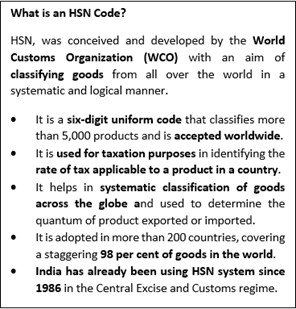
Why is HSN important under GST?
- Following GST implementation, the enactment of the HSN code in India brings the country at par with the other countries following HSN for years. India adopted the HSN code to standardise GST.
- This has also minimized the cost related to international trade as it will bring harmonization in trade processes.
- The HSN encourage each taxpayer in India to explore the GST rate by accessing the code. Subsequently, the system will automatically determine the tax rate relevant to the products under the GST, hence shortening and clarifying the trade-related methods in India. That is why it is obligatory to consider the correct search HSN codes throughout the GST Return filing under GST.
What can be the effects of wrong classification of goods/services i.e., use of a wrong HSN Code?
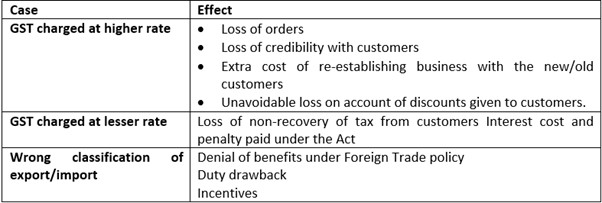
What can be done?
- The GST Council should commence the task of rationalising the HSN Codes for the purposes of GST while retaining them for the purpose of import and export.
- Since most of the litigation arises for the sub-headings under each Chapter of the Code, Codes can be limited to only the Chapter headings.
Sources:
Zero Budget Natural Farming
In News
The Prime Minister of India will addressed a national summit to popularize zero-budget natural farming (ZNBF), as policymakers prepare for a big push for the technique agricultural scientists say is unproven.
Understanding ZBNF
- What is it? Zero budget natural farming is a method of chemical-free agriculture drawing from traditional Indian practices.
- Origin: It was originally promoted by agriculturist Subhash Palekar in the mid-1990s as an alternative to the Green Revolution’s methods driven by chemical fertilizers, pesticides and intensive irrigation.
- On one hand, the rising cost of these external inputs was a leading cause of indebtedness and suicide among farmers, while on the other hand, it impacted the environment in terms of fertility.
- Hence ZBNF was introduced to avoid the need to spend money on these inputs nor take loans to buy them breaking the debt cycle for many small farmers.
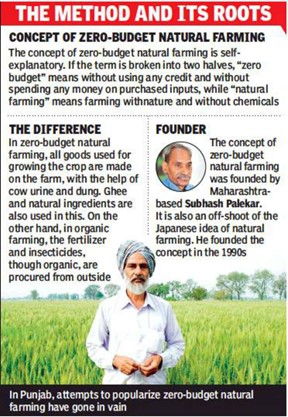
Benefits of ZBNF
- Use of Zero Chemical Inputs: Instead of commercially produced chemical inputs, ZBNF promotes the application of jivamrita which is a mixture of fresh cow dung and aged cow urine, jaggery, pulse flour, water and soil on farmland.
- This fermented microbial culture adds nutrients to the soil and acts as a catalytic agent to promote the activity of microorganisms and earthworms in the soil.
- Only one cow is needed for 30 acres of land that too a local Indian breed and not an imported Jersey or Holstein.
- A similar mixture, called bijamrita is used to treat seeds.
- Discourages intensive irrigation: ZBNF promotes soil aeration, minimal watering, intercropping, bunds and topsoil mulching and discourages intensive irrigation and deep ploughing.
- Reduces Input costs: According to National Sample Survey Office (NSSO) data, almost 70% of agricultural households spend more than they earn on inputs. In order to achieve the Central government’s promise to double farmers income by 2022, natural farming methods such as the ZBNF will reduce farmers’ dependence on loans to purchase inputs they cannot afford.
- Status in India: Andhra Pradesh has the biggest ambition to bring one lakh additional hectares of land under ZBNF under Paramparagat Krishi Vikas Yojana, followed by Chhattisgarh, with 85,000 additional hectares and Gujarat, with 71,000 additional hectares.
Concerns related to ZBNF
- Reports suggest that many farmers have reverted to conventional farming after seeing their ZBNF returns drop after a few years, in turn raising doubts about the method’s efficacy in increasing farmers’ incomes.
- ZBNF critics, including some experts within the Central policy and NITI Aayog, warn against a wholesale move away from the Green Revolution model without sufficient proof that yields will not be affected.
- Sikkim, which has seen some decline in yields following a conversion to organic farming, is used as a cautionary tale regarding the pitfalls of abandoning chemical fertilizers.
Source:
- The push for Zero Budget Natural Farming
- Punjab: Natural and minimalist but not a hit
- What is zero budget natural farming?
Image Source:
Vijay Diwas - Edukemy Current Affairs
On December 16, 1971, India emerged triumphant against Pakistan in 1971 war. India celebrates December 16 as "Vijay Diwas" commemorating this day. The ‘Instrument of Surrender’ was signed and accepted by Lieutenant General Jagjit Singh Arora, the then General Officer Commanding-in-Chief of India’s Eastern Command. The war, which lasted 13 days, ended with the surrender of nearly 90,000 Pakistani soldiers — the largest surrender by an Army since World War-II. India won the war decisively — splitting Pakistan into two, with the creation of Bangladesh. Bangladesh celebrates the day as ‘Bijoy Dibos’ to mark the country’s formal independence from Pakistan. Prominent personalities related to this war are R.N. Rao ( Chief of RAW), Field Marshal Sam Manekshaw (Chief of the Indian Army), Brigadier Kuldip Singh Chandpuri, Major General Ian Cardozo and Flying Officer Nirmal Jit Singh Sekhon.

Sources:
Development of Semiconductors and Display Manufacturing Ecosystem in India
In News
The Union Cabinet has approved the comprehensive program for the development of sustainable semiconductor and display ecosystem in the country.
Details of the Scheme
The financial outlay for the programme is Rs.76,000 crore (>10 billion USD).Following broad incentives have been approved for the development of semiconductors and display manufacturing ecosystem
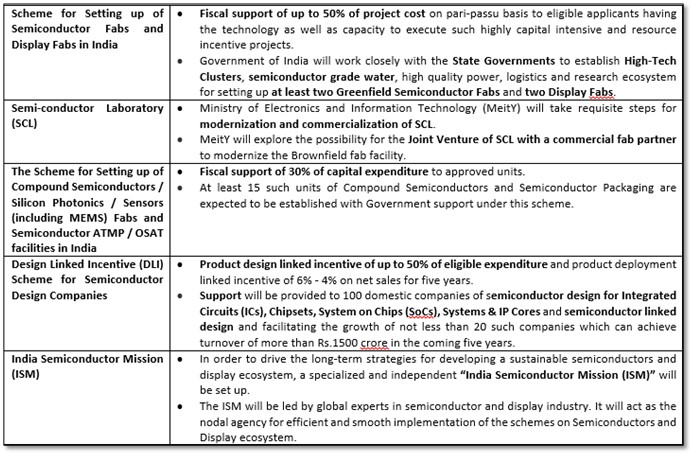
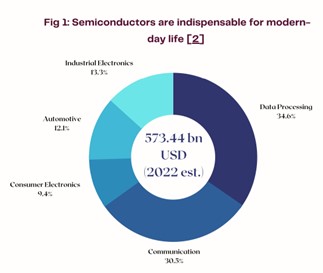
Why do Semiconductors Matter?
- Technological Importance: Technologies like 5G and Artificial Intelligence (AI) applications require new semiconductor architectures with faster data movement between processor and memory.
- Geopolitical Importance: The economics of the semiconductor supply chain makes it a viable geopolitical tool. Manufacturing facilities, equipment, and materials are concentrated in a handful of countries such as China, US, Vietnam. Semiconductors have become a major front in the US-China trade war.
- Economic Importance: Riding on the success of globalisation, today, the semiconductor industry contributes to nearly $2.3 trillion of the world's GDP. This includes both upstream & downstream contributions to economic value.
Semiconductor IC Landscape in India: Some Key Features

India’s Challenges in Semiconductor Industry
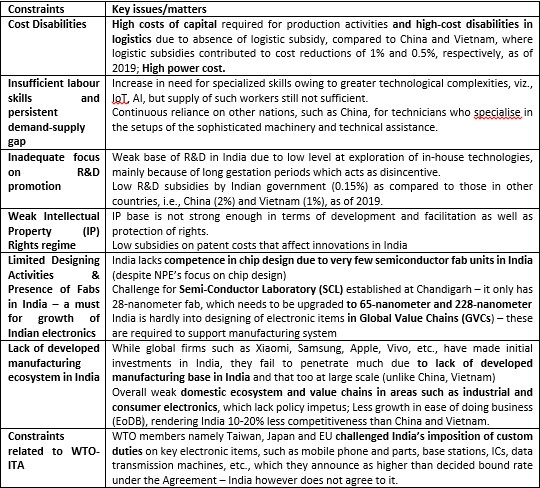
How does the present Programme address these challenges?
- The scheme is launched in furtherance of the vision of Aatmanirbhar Bharat and positioning India as the global hub for Electronic System Design and Manufacturing (ESDM).
- The programme aims to provide attractive incentive support to companies / consortia that are engaged in Silicon Semiconductor Fabs, Display Fabs, Compound Semiconductors / Silicon Photonics / Sensors (including MEMS) Fabs, Semiconductor Packaging (ATMP / OSAT), Semiconductor Design.
- The program will usher in a new era in electronics manufacturing by providing a globally competitive incentive package to companies in semiconductors and display manufacturing as well as design. This shall pave the way for India’s technological leadership in these areas of strategic importance and economic self-reliance.
- Semiconductors and displays are the foundation of modern electronics driving the next phase of digital transformation under Industry 4.0. Semiconductors and display manufacturing is very complex and technology-intensive sector involving huge capital investments, high risk, long gestation and payback periods, and rapid changes in technology, which require significant and sustained investments. The program will give an impetus to semiconductor and display manufacturing by facilitating capital support and technological collaborations.
Conclusion: In the current geopolitical scenario, trusted sources of semiconductors and displays hold strategic importance and are key to the security of critical information infrastructure. The approved program will propel innovation and build domestic capacities to ensure the digital sovereignty of India. It will also create highly skilled employment opportunities to harness the demographic dividend of the country. Development of semiconductor and display ecosystem will have a multiplier effect across different sectors of the economy with deeper integration to the global value chain. The program will promote higher domestic value addition in electronics manufacturing and will contribute significantly to achieving a USD 1 Trillion digital economy and a USD 5 Trillion GDP by 2025.
Question: The Programme for Development of Semiconductors and Display Manufacturing Ecosystem in India will propel innovation and build domestic capacities to ensure the digital sovereignty of India. Discuss with specific reference to challenges of semiconductor industries in India.
Sources:
- In the current geopolitical scenario, trusted sources of semiconductors and displays hold strategic importance and are key to the security of critical information infrastructure
- Is semiconductor manufacturing in India an unworkable project?
- India’s Electronics Industry: Potential for Domestic Manufacturing and Exports
- India's Semiconductor Ecosystem: A SWOT Analysis
UNESCO Intangible Cultural Heritage to Durga Puja in Kolkata
This is image of Durga Puja celebration in Kolkata, which has just been inscribed on the UNESCO’s Representative List of the Intangible Cultural Heritage of Humanity. Inscriptions to the Representative List are one of the several ways by which UNESCO advocates the promotion and safeguarding of intangible cultural heritage. UNESCO also commended the concerned organisations in Kolkata for their initiatives to involve marginalised groups and individuals as well as women in their participation for safeguarding the Intangible Cultural Heritage. With the inclusion of Durga Puja, the number of elements in the list of Intangible Cultural Heritage from India has increased to 14. The latest inclusion in the list prior to the Durga Puja is the Kumbh Mela in 2017. Yoga was included in 2016. The festival is characterized by large-scale installations and pavilions in urban areas, as well as by traditional Bengali drumming and veneration of the goddess. During the event, the divides of class, religion and ethnicities collapse as crowds of spectators walk around to admire the installations.

Sources:
National Livestock Mission
- Context: The National Livestock Mission (NLM) scheme has been realigned during 2021-22.
- NLM launched in 2014, seeks to ensure quantitative and qualitative improvement in livestock production systems and capacity building of all stakeholders.
- The scheme is being implemented as a sub scheme of White Revolution - Rashtriya Pashudhan Vikas Yojana since 2019.
- The objectives of the National Livestock Mission are:
- Employment generation through entrepreneurship development in small ruminant, poultry, piggery and Fodder sector.
- Increase of per animal productivity (meat, egg, goat milk, wool and fodder) through breed improvement.
- Encouraging establishment of fodder processing units to reduce the demand supply gap
- Promoting risk management measures including livestock insurance for farmers.
- Promoting skill-based training and dissemination of technologies for reducing cost of production and improving production of livestock sector etc.
- The salient features of realigned scheme are employment generation, entrepreneurship development, increase in per animal productivity and thus targeting increased production of meat, goat milk, egg and wool.

Source:
Image Source:
National Leprosy Eradication Programme
- Context: National Leprosy Eradication Programme (NLEP) has shown significant Progress from 2014 to 2021.
- NLEP is a Centrally Sponsored Scheme under the National Health Mission (NHM).
- Its mission is to provide quality leprosy services free of cost to all sections of the population, with easy accessibility, through the integrated healthcare system, including care for disability after cure of the disease.
- It aims at eliminating leprosy in each of the districts in India by 2030.
- The main strategies of NLEP include:
- Integrated anti-leprosy services through General Health Care system.
- Early detection and complete treatment of new leprosy cases.
- Involvement of Accredited Social Health Activist (ASHA) in the detection and completion of treatment of Leprosy cases on time.
- Strengthening of Disability Prevention and Medical Rehabilitation (DPMR) services.
- Information, Education and Communication (IEC) activities in the community to improve self-reporting to Primary Health Centre (PHC) and reduction of stigma.
- India has achieved the elimination of leprosy as a public health problem e., defined as less than 1 case per 10,000 populations, at the National level.
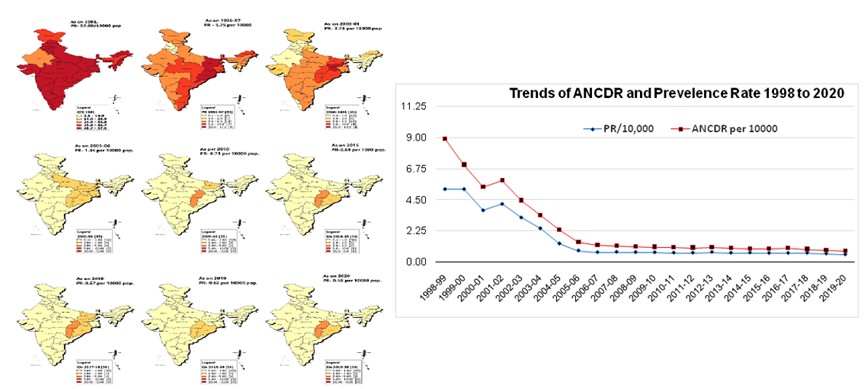
Source:
Image Source:
Global Gateway
- Context: The European Commission has recently announced Global Gateway, a move seen as a response to China’s Belt and Road strategy.
- Global Gateway is an investment project of the EU that aims to mobilise €300 billion ($340 billion) in public and private infrastructure investment around the world between 2021 and 2027.
- It is a roadmap for major investment that brings together resources of the EU, member states, European financial institutions and national development finance institutions.
- This will offer developing countries an alternative to Belt and Road Initiative (BRI) of China.
- BRI is a global investment strategy introduced in 2013 to develop land and sea infrastructure to better connect China to Asia, Europe and Africa for trade and development.
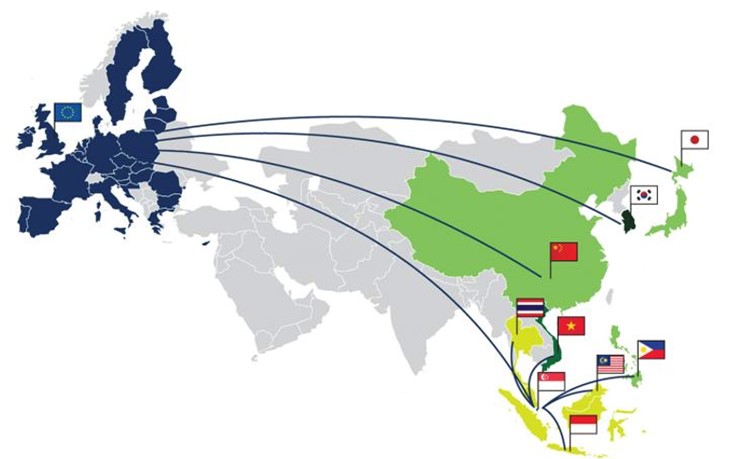
Source:
- EU plans €300 billion infrastructure fund to counter China’s BRI
- Global Gateway: up to €300 billion for the European Union's strategy to boost sustainable links around the world
Image Source:
Supersonic missile-assisted torpedo system
- Context: A supersonic missile-assisted torpedo (SMART) system has been successfully launched from the Wheeler Island in Odisha recently.
- Torpedoes are self-propelled weapons with a warhead and can be usedunder or on the water surface. They are one of the mainstay of sea-warfare attack systems.
- The system is a next generation missile-based standoff torpedo delivery system developed by the DRDO.
- It has been designed to enhance anti-submarine warfare capability far beyond the conventional range of the torpedo.
- It is a canister-based missile system consisting of advanced technologies - two-stage solid propulsion, electro-mechanical actuators and precision inertial navigation.

Source:
- Supersonic missile-assisted torpedo system successfully launched: DRDO
- DRDO’s Supersonic missile assisted torpedo system successfully launched
Image Source:
Strengthening India-Vietnam Friendship: IDSA
Essence: The article speaks about the high-level in-person meeting to be held between India and Vietnam. The visit of Chairman of Vietnam National Assembly would mark 50 years of diplomatic relationship and 5 years of Comprehensive Strategic Partnership between the 2 nations. Both nations are jointly active at international fora like UN, WTO, etc. for promoting global south cooperation, mitigation of climate change, rights of developing nations, maritime security, renewable energy, etc. Peace (combatting terrorism), trade and prosperity and people to people exchange would receive a boost.
India has assisted Vietnam in providing Speed Guard Boats, enhancing Quick Impact Projects, heritage conservation, cooperation in clean energy, medical science, IT, etc.
An area of concern for Vietnam, China’s presence, could be countered through increased presence of Indian navy, joint exercises in South China Sea, providing BrahMos and Akash missile for effective defense.
Why you should read this article?
- To understand the areas of cooperation and venture between India and Vietnam.
- To analyze the possibility of India countering China at its backyard with the help of Vietnam.
Source:
The price of food must figure in the policy: TH
Essence: The article draws attention on the problem of high price of food in India which needs intervention on part of the government. High price of food has its repercussions like crowding out expenditure on other items like health, education and non-agricultural goods. Due to this market for non-agricultural goods is not been able to expand.
The increase in cost due to lack of proper transportation and cold storage facilities poses a major problem that should also be taken care of. So, in India, the agricultural policy should ensure that increasing the profitability in farming should not be at the cost of high prices of food. The aim of making the food available from domestic sources represents only a narrow spectrum of the problem. What India needs is the increase in yields that will ensure that food prices do not rise and the less money is spent on food items as a part of total family budget.
Why you should read this article?
- To understand the problem of price rise in food crops in India.
- To understand the ramifications due to high food prices.
- To understand the lacunas in the current intervention by the government to regulate the food prices.
- To understand what could be the plausible solution to the problem.
Source:
A false conflation between duties and rights: TH
Essence: All rights come with duties. But those duties are different as ascribed in popular culture. The Government puts forward an idea that rights can be made conditional on the performance of a set of obligations. It is important to note that Part III of the Constitution places certain restrictions but none of those restrictions places a burden on the citizens to perform his duties. Duties are essential but when there is a popular discourse to place duties over rights, the ethos of Constitution is defeated. It is in fact only the guarantee of rights that could lead India into free and egalitarian future.
The issue of duties and rights must bring to our minds certain questions like does the right to life include within it a positive obligation on the state to provide shelter, livelihood and health care? The language of Fundamental duties as in Article 51 A should not subsume are political debates on the crucial issues of our Rights.
Why to read this article?
- To understand that though Fundamental Duties are essential, why it is against the ethos of Constitution to keep duties over rights.
- The article discusses the idea of the Constitution framers on the issue of Rights, Swaran Singh Committee and Article 51 A which provides a background to understand the relevance of Rights and Duties (GS II).
Source:
New sustainability model for consuming resources
Background
- Cochin Airport has scaled up agri-voltaic farming with the development of Agro-Voltic Farm, largest of its kind in the country.
- It is a significant milestone in sustainable development.
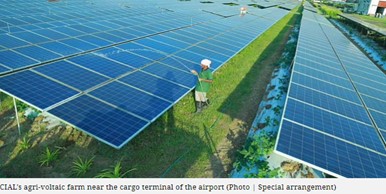
About the Agro-Voltic Farm at Cochin Airport
- Under Agricultural photovoltaic (Agri-PV), the land is used for both agriculture and solar power generation at the same time. It is an evolving practice in sustainable development that combines the production of food and energy.
- The water used to clean solar photovoltaic panels is being used to irrigate the crops. The crops are expected to modify the micro-climates underneath PV modules by reducing the temperature, which results in increasing efficiency in power generation.
- The crop coverage in between PV arrays will check the erosion of soil and thus reduce the dust load on the PV module. The cultivation also dampens the weed growth underneath the PV panel mounts.
- APV will overcome the present either-or situation by achieving both power generation and agricultural yield.
Where can this case be used?
Building of Resilient Infrastructure, Climate-Change Performance Goals and India’s Initiatives (Public+ Private), Renewable sources.
Quote
"This is our world, a common world. Everybody should feel a common responsibility".
Source:
Share the article
Get Latest Updates on Offers, Event dates, and free Mentorship sessions.

Get in touch with our Expert Academic Counsellors 👋
FAQs
UPSC Daily Current Affairs focuses on learning current events on a daily basis. An aspirant needs to study regular and updated information about current events, news, and relevant topics that are important for UPSC aspirants. It covers national and international affairs, government policies, socio-economic issues, science and technology advancements, and more.
UPSC Daily Current Affairs provides aspirants with a concise and comprehensive overview of the latest happenings and developments across various fields. It helps aspirants stay updated with current affairs and provides them with valuable insights and analysis, which are essential for answering questions in the UPSC examinations. It enhances their knowledge, analytical skills, and ability to connect current affairs with the UPSC syllabus.
UPSC Daily Current Affairs covers a wide range of topics, including politics, economics, science and technology, environment, social issues, governance, international relations, and more. It offers news summaries, in-depth analyses, editorials, opinion pieces, and relevant study materials. It also provides practice questions and quizzes to help aspirants test their understanding of current affairs.
Edukemy's UPSC Daily Current Affairs can be accessed through:
- UPSC Daily Current Affairs can be accessed through Current Affairs tab at the top of the Main Page of Edukemy.
- Edukemy Mobile app: The Daily Current Affairs can also be access through Edukemy Mobile App.
- Social media: Follow Edukemy’s official social media accounts or pages that provide UPSC Daily Current Affairs updates, including Facebook, Twitter, or Telegram channels.

